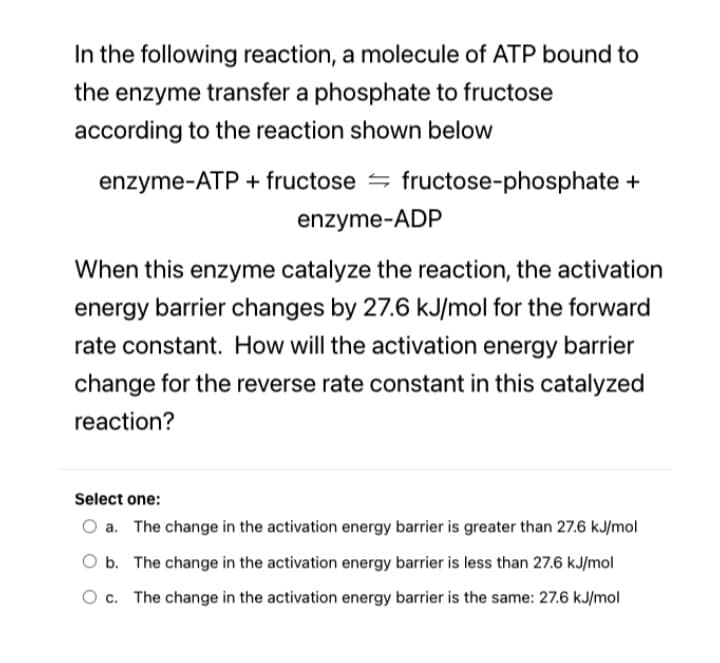In the following reaction, a molecule of ATP bound to the enzyme transfer a phosphate to fructose according to the reaction shown below enzyme-ATP + fructose = fructose-phosphate + enzyme-ADP When this enzyme catalyze the reaction, the activation energy barrier changes by 27.6 kJ/mol for the forward rate constant. How will the activation energy barrier change for the reverse rate constant in this catalyzed reaction? Select one: a. The change in the activation energy barrier is greater than 27.6 kJ/mol O b. The change in the activation energy barrier is less than 27.6 kJ/mol Oc. The change in the activation energy barrier is the same: 27.6 kJ/mol
In the following reaction, a molecule of ATP bound to the enzyme transfer a phosphate to fructose according to the reaction shown below enzyme-ATP + fructose = fructose-phosphate + enzyme-ADP When this enzyme catalyze the reaction, the activation energy barrier changes by 27.6 kJ/mol for the forward rate constant. How will the activation energy barrier change for the reverse rate constant in this catalyzed reaction? Select one: a. The change in the activation energy barrier is greater than 27.6 kJ/mol O b. The change in the activation energy barrier is less than 27.6 kJ/mol Oc. The change in the activation energy barrier is the same: 27.6 kJ/mol
Chemistry: Principles and Reactions
8th Edition
ISBN:9781305079373
Author:William L. Masterton, Cecile N. Hurley
Publisher:William L. Masterton, Cecile N. Hurley
Chapter11: Rate Of Reaction
Section: Chapter Questions
Problem 71QAP: For a certain reaction, Ea is 135 kJ and H=45 kJ. In the presence of a catalyst, the activation...
Related questions
Question
I want clear handwritten solution only.

Transcribed Image Text:In the following reaction, a molecule of ATP bound to
the enzyme transfer a phosphate to fructose
according to the reaction shown below
enzyme-ATP + fructose = fructose-phosphate +
enzyme-ADP
When this enzyme catalyze the reaction, the activation
energy barrier changes by 27.6 kJ/mol for the forward
rate constant. How will the activation energy barrier
change for the reverse rate constant in this catalyzed
reaction?
Select one:
O a. The change in the activation energy barrier is greater than 27.6 kJ/mol
O b. The change in the activation energy barrier is less than 27.6 kJ/mol
O c. The change in the activation energy barrier is the same: 27.6 kJ/mol
Expert Solution
This question has been solved!
Explore an expertly crafted, step-by-step solution for a thorough understanding of key concepts.
This is a popular solution!
Trending now
This is a popular solution!
Step by step
Solved in 2 steps with 2 images

Knowledge Booster
Learn more about
Need a deep-dive on the concept behind this application? Look no further. Learn more about this topic, chemistry and related others by exploring similar questions and additional content below.Recommended textbooks for you

Chemistry: Principles and Reactions
Chemistry
ISBN:
9781305079373
Author:
William L. Masterton, Cecile N. Hurley
Publisher:
Cengage Learning

Chemistry by OpenStax (2015-05-04)
Chemistry
ISBN:
9781938168390
Author:
Klaus Theopold, Richard H Langley, Paul Flowers, William R. Robinson, Mark Blaser
Publisher:
OpenStax

Chemistry for Engineering Students
Chemistry
ISBN:
9781337398909
Author:
Lawrence S. Brown, Tom Holme
Publisher:
Cengage Learning

Chemistry: Principles and Reactions
Chemistry
ISBN:
9781305079373
Author:
William L. Masterton, Cecile N. Hurley
Publisher:
Cengage Learning

Chemistry by OpenStax (2015-05-04)
Chemistry
ISBN:
9781938168390
Author:
Klaus Theopold, Richard H Langley, Paul Flowers, William R. Robinson, Mark Blaser
Publisher:
OpenStax

Chemistry for Engineering Students
Chemistry
ISBN:
9781337398909
Author:
Lawrence S. Brown, Tom Holme
Publisher:
Cengage Learning

Principles of Modern Chemistry
Chemistry
ISBN:
9781305079113
Author:
David W. Oxtoby, H. Pat Gillis, Laurie J. Butler
Publisher:
Cengage Learning


Chemistry: An Atoms First Approach
Chemistry
ISBN:
9781305079243
Author:
Steven S. Zumdahl, Susan A. Zumdahl
Publisher:
Cengage Learning